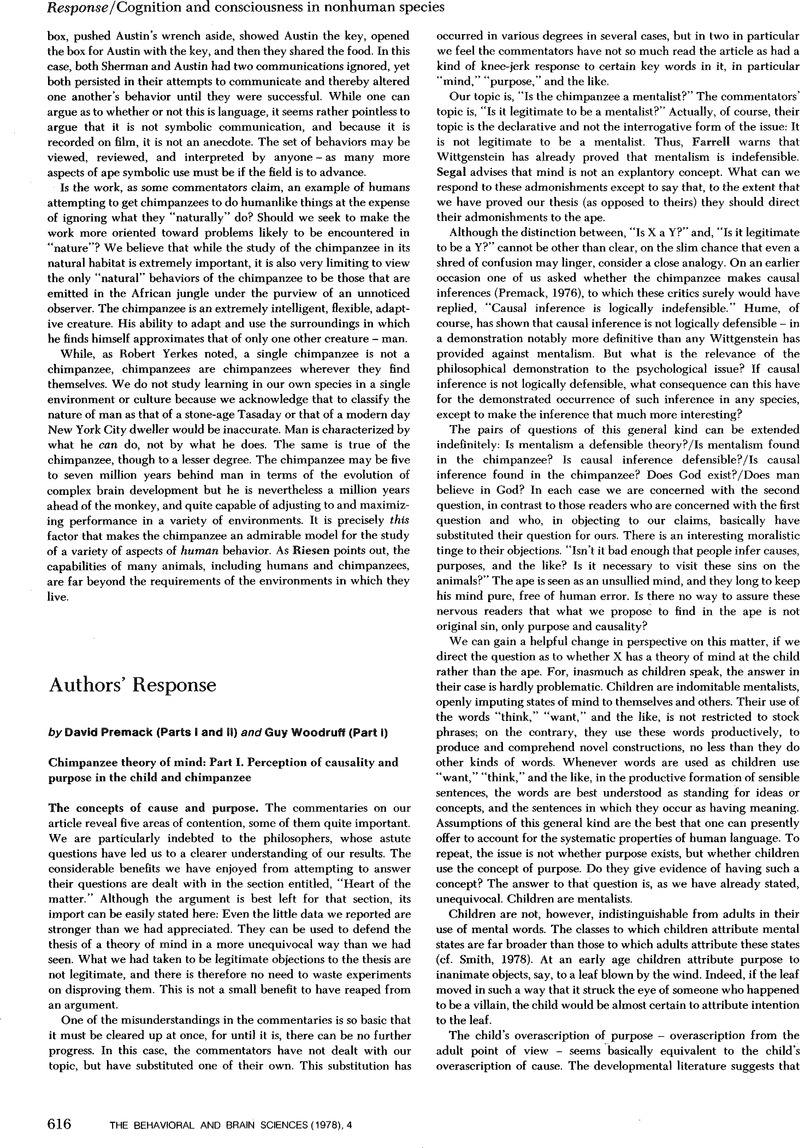Crossref Citations
This article has been cited by the following publications. This list is generated based on data provided by Crossref.
Savage-Rumbaugh, Sue
Scanlon, John L.
and
Rumbaugh, Duane M.
1980.
Communicative intentionality in the chimpanzee.
Behavioral and Brain Sciences,
Vol. 3,
Issue. 4,
p.
620.
Griffin, Donald R.
1980.
What do animals think?.
Behavioral and Brain Sciences,
Vol. 3,
Issue. 4,
p.
618.
Lindauer, Martin
1980.
Cognition and consciousness - their evolutionary gradients.
Behavioral and Brain Sciences,
Vol. 3,
Issue. 4,
p.
615.
Shannon, Benny
1980.
The significance of self-awareness.
Behavioral and Brain Sciences,
Vol. 3,
Issue. 4,
p.
618.
Schwartz, Robert
1980.
How rich a theory of mind?.
Behavioral and Brain Sciences,
Vol. 3,
Issue. 4,
p.
616.
Ristau, Carolyn A.
and
Robbins, Donald
1982.
Vol. 12,
Issue. ,
p.
141.
Povinelli, Daniel J.
1996.
GROWING UP APE.
Monographs of the Society for Research in Child Development,
Vol. 61,
Issue. 3,
p.
174.
Semerari, Antonio
Cucchi, Michele
Dimaggio, Giancarlo
Cavadini, Daniele
Carcione, Antonino
Battelli, Vittoria
Nicolò, Giuseppe
Pedone, Roberto
Siccardi, Tomaso
D′Angerio, Stefania
Ronchi, Paolo
Maffei, Cesare
and
Smeraldi, Enrico
2012.
The development of the Metacognition Assessment Interview: Instrument description, factor structure and reliability in a non-clinical sample.
Psychiatry Research,
Vol. 200,
Issue. 2-3,
p.
890.
Dosi, Ifigeneia
and
Douka, Gerakini
2021.
Effects of language proficiency and contextual factors on second language learners’ written narratives: A corpus-based study.
International Journal of Research Studies in Education,
Vol. 10,
Issue. 5,
O’Grady, Aneyn M.
and
Nag, Sonali
2022.
“Where’s Wally?” Identifying theory of mind in school-based social skills interventions.
Frontiers in Psychology,
Vol. 13,
Issue. ,
Hand, Christopher J.
Kennedy, Ashley
Filik, Ruth
Pitchford, Melanie
and
Robus, Christopher M.
2023.
Emoji Identification and Emoji Effects on Sentence Emotionality in ASD-Diagnosed Adults and Neurotypical Controls.
Journal of Autism and Developmental Disorders,
Vol. 53,
Issue. 6,
p.
2514.
Henderson, Antonia J.Z.
2025.
Equine Welfare in Clinical Practice.
p.
147.


